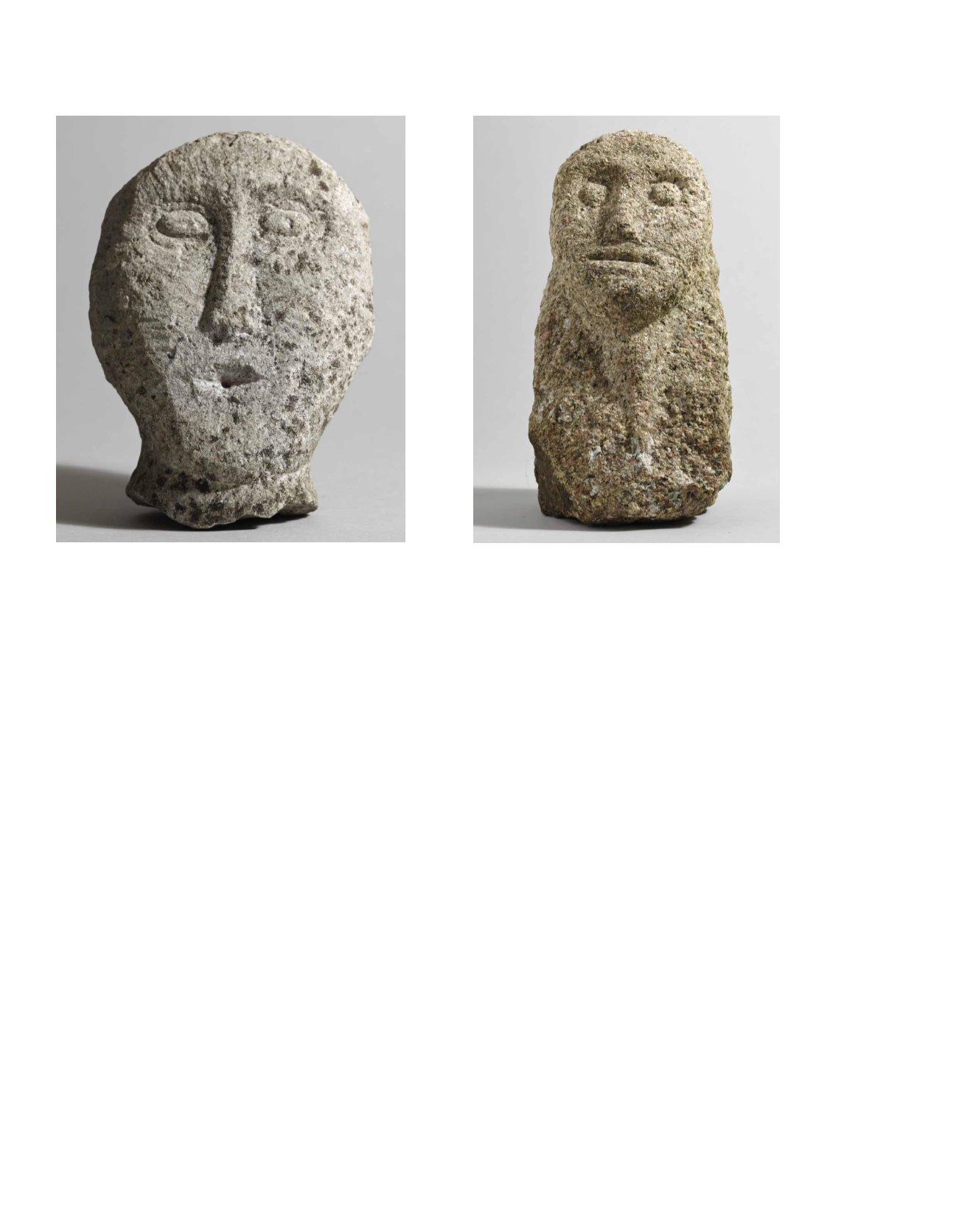

6
WHYTES
SINCE 1783
,
1
Circa 500BC to 500AD Iron Age. Irish stone head.
Limestone; broken at the base, lower part of mouth chipped. Weight:
3.52kg. The flattish facial composition comprises protuberant lentoid
eyes with lightly defined eyelids, elongated triangular nose, and narrow
open mouth, with minimally defined lips. There is a small hole (diameter:
4mm) in the centre of the mouth. The head is oval, with a narrow chin.
In addition, the ears have been rendered as a large C-shaped raised
outline at either side of the head.
It is notoriously difficult to be certain about the dating of an isolated
stone head. The introduction of the carved stone head in Ireland can be
traced to the Iron Age, but representations of the human head
continued to be produced into the medieval period and beyond. Lorrha,
Co. Tipperary is renowned for the wealth of its medieval heritage, but
this stone head differs stylistically from the medieval examples at Lorrha,
and there are reasonable grounds for regarding it as a prehistoric object.
The Iron Age (‘Celtic’) carved stone head is characterised by simplicity of
form. In the words of Barry Raftery, an authority on the Iron Age in
Ireland, ‘the realistic portrayal of the human form was of no great
concern to Celtic craftsmen’. This stone head possesses a spare, primitive
quality contrasting with the more naturalistic examples from the
medieval period.
A number of stone heads provide parallels for this item, including one in
Wakefield Museum, Yorkshire, dated 600 BC-AD 43, an example from
Trabolgan, now in the National Museum of Ireland, and another in the
Metropolitan Museum of Art, New York, dated to the second to third
centuries.
Etienne Rynne, writing on the corpus of Celtic stone heads in Ireland in
1972 noted that ‘the hole in the mouth feature seems to be
characteristic of some Celtic stone heads’. It has been suggested that it
could be connected to the pouring of a liquid offering or libation into
the mouth of the deity represented by the carved stone head during
ceremonies.
The understated economy of the work suggests that this could well be a
stone head dating from the Iron Age, although it must be recognised
that such carved heads could be of more recent origin.
Ken Wiggins BA MPhil MIAI MIfA
9 x 5 x 4in. (22.86 x 12.70 x 10.16cm)
Provenance: In the ownership of a family at Lorrha, Co. Tipperary for c.
100 years.
€
6,000-
€
8,000 (£4,800-£6,400 approx)
2
500BC to 500AD Iron Age. Irish stone head.
Granite, angled break at the base along one side. Weight: 8.78kg.
Irregular, upright stone with flat base. The surface has rough overall
texture, apart from the detail of the head/face and a tapered raised
feature at the front, directly below the head. The back of the stone is
curved. The outline of the head is smooth, projecting at an upward angle
from the body of the stone.
Etienne Rynne, in considering the corpus of carved stone heads in
Ireland in 1972, noted that the dating of these objects was ‘extremely
difficult’, as features of pagan heads are paralleled in heads from the
medieval period. Carved stone heads from the Iron Age in general are
distinguished by simplicity in terms of the execution of the facial
composition. In this instance, the work comprises nearly circular, slightly
bulging eyes, broad nose and wide slit mouth with minimal definition of
the lips. The only other area of the stone to be skilfully fashioned is in
regard to a subtle, tapering ‘throat’ outlined below the front of the
head. No attempt was made to define the ears or to include the hairline.
Medieval stone heads in general were designed to project from a wall,
like corbels, or in doorway arches. This stone head, with its flat base and
upward tilting face, does not appear to have been designed to fit into a
wall in that way, but seems intended to function more as a portable
item, like a bust.
The wide mouth can be compared to a stone figure on a large stele from
Holzgerlingen, Wurttemberg, dated to c. 380 BC, and a head from the
sanctuary of Roquepertuse near Aix-en-Province, dated to the fourth
century BC. The combination of circular eyes and broad nose has
affinities with pre-Christian stone carvings kept at Armagh Cathedral. A
face carved into a stone block at Camlyball, near Newtownhamilton, Co.
Armagh, has round eyes, contrasting with the lentoid eye forms that
typify many instances of prehistoric stone heads.
The simplified style of the object suggests that the head could date from
the Iron Age, although with an isolated find of this nature, it is never
absolutely certain that it is of prehistoric origin.
Ken Wiggins BA MPhil MIAI MIfA
10 x 4.70 x 6.70in. (25.40 x 11.94 x 17.02cm)
Provenance: From a 300 year old house, Claregalway, Co. Galway.
€
5,000-
€
7,000 (£4,000-£5,600 approx)
1
2



















